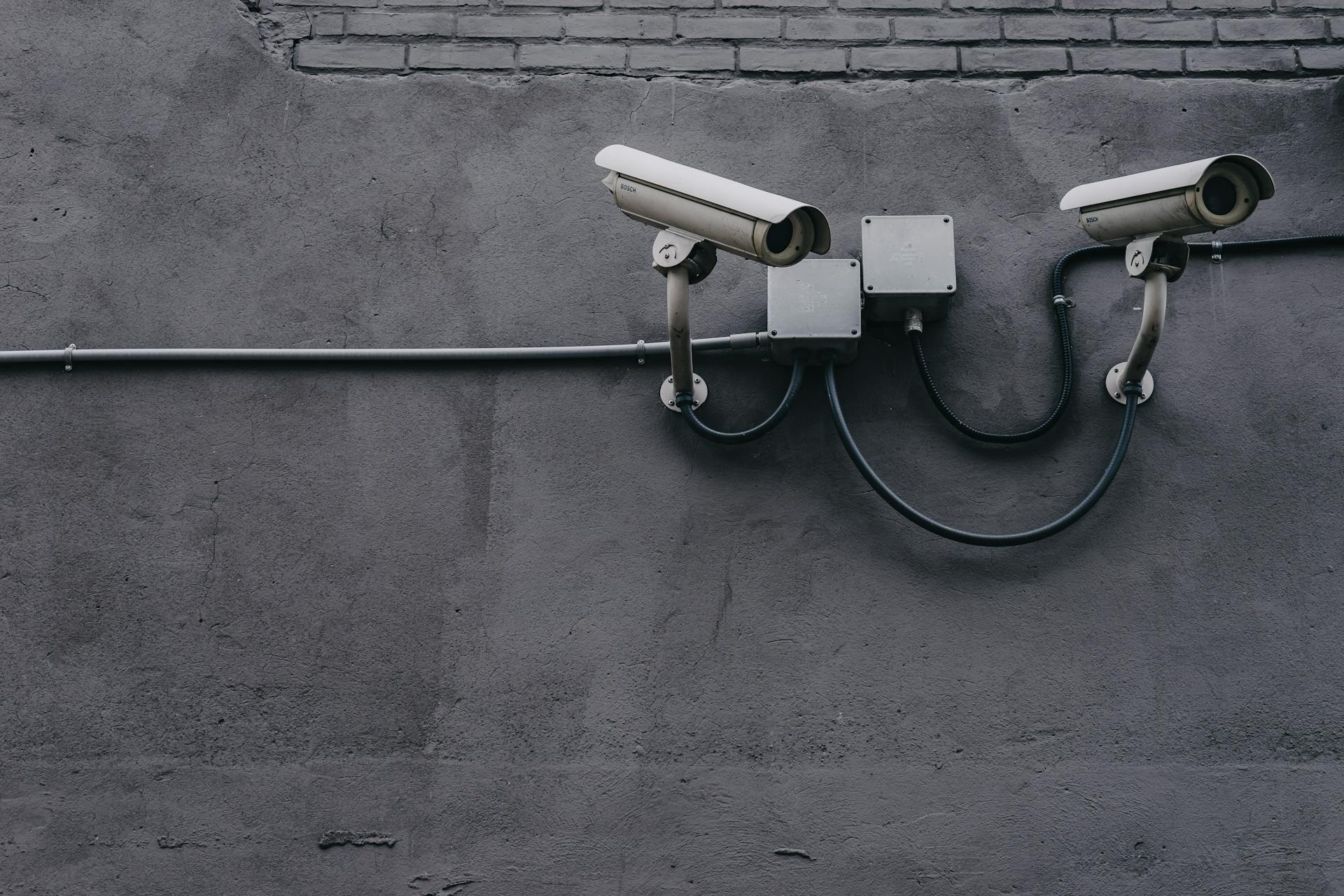
The PCI DSS vulnerability scan process is a crucial step in ensuring the security of your payment card industry data.
The process starts with a network scan, which identifies potential vulnerabilities in your network, such as open ports and misconfigured systems.
A vulnerability scan is not a penetration test, but rather a method of identifying potential entry points for attackers.
The scan results are then analyzed to determine the severity of each vulnerability and whether it poses a risk to your data.
Recommended read: First Data Pci Compliance
Scanning Requirements and Best Practices
To ensure a thorough PCI DSS vulnerability scan, it's essential to understand the scanning requirements and best practices. An automated web security scanner checks the systems and IT infrastructure of the merchant, service provider, payment gateway, and third-party payment processor for vulnerabilities.
The scanner will check for flaws an attacker could exploit to infiltrate the systems and access personal data by examining networks, online applications, operating systems, services, devices, and other components. This includes both internal and external vulnerability scanning methodologies, which generate a full report on the vulnerabilities discovered, along with recommendations for further reading and ways to patch them.
For external scans, scanners from PCI SSC Approved Scanning Vendors (ASV) are necessary.
On a similar theme: Smart Contract Vulnerabilities
What Does ASV Mean for External Network Scans?

ASV stands for Approved Scan Vendor, and it's a company that provides security scanning services approved by the PCI SSC to perform external network tests. These companies are certified and must perform external network scans to ensure your network is secure and safe for users.
You can find over 100 ASV companies on the PCI SSC website, so you have many options to choose from. You should work with an ASV company suitable for your business.
ASV companies must enter the certificate renewal process every year, where they run the PCI scan tool on sites full of vulnerabilities approved by the PCI Council. This ensures the tool is effective in identifying vulnerabilities.
The ASV will provide you with a result report after the scan is completed. You are responsible for correcting any errors found in the report.
Expand your knowledge: Pci Compliance Company
Meeting Security Scan Requirements
Meeting security scan requirements is crucial for any organization handling credit and debit card data. You must perform vulnerability scans annually and after every significant change to ensure you're meeting the requirements.

The Payment Card Industry Data Security Standard (PCI DSS) defines a significant change as one that may introduce new vulnerabilities or affect the protection of cardholder data. Examples of significant changes include adding new servers, changing interfaces, and upgrading products.
To determine if a change is significant, consider if it introduces new vulnerabilities or affects the protection of cardholder data. If you're unsure, it's best to err on the side of caution and perform a vulnerability scan.
Here are some examples of non-significant changes that don't require a vulnerability scan:
- Replacing file integrity monitoring (FIM) software
- Replacing antivirus products
- Removing dismissed administrative personnel from the records
However, if you make significant changes to your system after your quarterly external scan, you should perform a vulnerability scan as soon as possible to ensure your system is secure.
It's also essential to choose an approved scanning vendor (ASV) or a qualified security assessor (QSA) to perform the vulnerability scan. ASVs are businesses permitted by the PCI Security Standards Council (SSC) to carry out PCI vulnerability scans.
When selecting an ASV or QSA, look for one that is partially independent of the scanned system to avoid conflicts of interest. For example, if the person performing the scan is also responsible for fixing the vulnerabilities, it may create a conflict of interest.
By following these guidelines and performing regular vulnerability scans, you can ensure you're meeting the security scan requirements and protecting your organization from costly fines and penalties.
Expand your knowledge: Pci Compliance Qsa
Types of Scans

External scans are a crucial part of maintaining a secure network. An ASV must perform external scanning, examining every public IP address range and network firewall.
The type of scan that must be performed is an external scan, which remotely scans a network for security holes. An expert ASV like Indusface employs a zero-intrusion, intelligent web vulnerability scanner to conduct these scans.
A passing scan is required, and any vulnerabilities discovered can lead to exclusion from the scan. You'll need to resolve the issue before receiving a passing scan.
External scans are a necessary step in establishing a secure network.
For more insights, see: Pci Dss Asv Scan
Comparison with Penetration Testing
A PCI DSS vulnerability scan is not the same as a penetration test. It's a crucial distinction to make when it comes to ensuring the security of your network.
Vulnerability scanning is typically done with automated tools, which can provide information about your network security on a regular basis, such as weekly, monthly, or quarterly. This gives you a snapshot of potential vulnerabilities, but it's not a hands-on assessment.
You might enjoy: Pci Dss Information Security Policy

In contrast, a penetration test requires a live person to actively investigate the network's complexity. This is a more detailed assessment of your overall cybersecurity posture.
To understand the difference more clearly, let's look at the following two main variations:
- Automated tools vs. live person: Vulnerability scanning uses automated tools, while penetration testing requires a live person to investigate the network.
- Revealing vulnerabilities vs. finding root causes: A vulnerability scan only reveals potential vulnerabilities, while a penetration test checks the vulnerability and finds its root cause, providing access to protected networks or stored sensitive data.
Practically, both vulnerability scans and penetration tests must be implemented to ensure maximum network protection.
Importance and Benefits
Running a PCI DSS vulnerability scan is a must-do for companies handling credit and debit card data. It helps identify security risks and potential threats that can come out of the blue.
Regular vulnerability scans are necessary to adhere to the stringent standards of the PCI DSS framework. This framework calls for PCI vulnerability screening and protects companies from costly fines and penalties for breaking the rules.
By performing routine vulnerability assessments, businesses can avoid huge penalties and fines, which can lead to significant monetary losses and even bankruptcy. In fact, performing regular vulnerability scans can guarantee a secure environment for credit and debit card transactions.
Additional reading: Pci Compliance Fines

Here are the key benefits of PCI DSS vulnerability scans:
- Identify security risks and potential threats.
- Adhere to the stringent standards of the PCI DSS framework.
- Enhance security posture long-term for the organization.
- Improve incident response capabilities.
Regular vulnerability scans can also help businesses demonstrate to partners and customers that they are taking security measures to protect payment card information, which can boost customer confidence and trust in the business.
Getting Started and Requirements
To get started with PCI DSS vulnerability scanning, you'll need to identify the scope of activities for your scan. This involves determining which systems, networks, and applications fall under the purview of PCI DSS compliance.
You'll then need to choose an approved scanning vendor (ASV) or a qualified security assessor (QSA). ASVs are businesses permitted by the PCI Security Standards Council (SSC) to carry out PCI vulnerability scans.
The systems and networks you want to scan must be prepared for the scanning process. This may involve ensuring they're operational and reachable, getting the required authorizations for the scanning software, and alerting the appropriate parties to the impending scan.
A unique perspective: Nearby Device Scanning

Here are the steps you can follow to implement PCI DSS vulnerability scanning in your organization:
- Identify the Scope of Activities for Your Scan
- Choose an approved scanning vendor (ASV) or a qualified security assessor (QSA)
- Prepare the Systems and Networks for Scanning
- Performing the Vulnerability Scan
- Assessing the Weaknesses Found in the Scan
Note: This is a general outline of the steps involved in getting started with PCI DSS vulnerability scanning. The specific requirements may vary depending on your organization's needs and the PCI DSS version you're working with.
Qualified Internal Source for Scanning
To perform internal vulnerability scans, you need a qualified internal source. This person should be partially independent of the scanned system to avoid conflicts of interest.
A qualified person is someone who can run internal scans without being in control of the system being scanned. This could be a security professional, your ASV, or an employee who doesn't manage the system.
For example, you can run internal scans of your firewalls from a qualified security professional. Having only one staff member in control of the system is not a valid reason to perform scans.
Broaden your view: Cyber Security Pci Compliance
Getting Started with Scanning

To get started with scanning, you'll need to identify the scope of activities for your scan. This involves determining which systems, networks, and applications fall under the purview of PCI DSS compliance to determine the vulnerability scan's scope.
You'll also need to choose an approved scanning vendor (ASV) or a qualified security assessor (QSA). ASVs are businesses permitted by the PCI Security Standards Council (SSC) to carry out PCI vulnerability scans.
Here are the steps to follow:
- Identify the systems, networks, and applications that fall under the purview of PCI DSS compliance.
- Choose an ASV or QSA.
- Prepare the systems and networks for scanning.
- Perform the vulnerability scan using specialized scanning tools.
- Assess the weaknesses found in the scan and provide remediation suggestions.
It's essential to note that external scans must be performed by an ASV, while internal scans can be carried out internally or under contract with the ASV.
Resource Guide
The PCI Security Standards Council has created a Resource Guide to help you understand the requirements for external vulnerability scans. This guide focuses on SAQ A merchants, who are now required to complete PCI DSS Requirement 11.3.2 for the first time.
The guide is intended for anyone with questions about ASV scans, with a focus on SAQ A merchants since they are completing PCI DSS Requirement 11.3.2 for the first time.
Intriguing read: Pci Dss Quick Reference Guide
ASV scan requirements in SAQ A only apply to e-commerce merchant systems that host the webpage that redirects payment transactions to a PCI DSS compliant third-party service provider or includes an embedded payment page/form from a PCI DSS compliant TPSP.
Merchants need to scan for and resolve identified vulnerabilities that could potentially expose their link to the TPSP's payment page.
Frequently Asked Questions
How much does an ASV scan cost?
An ASV scan costs between $150-200 per IP annually, with quarterly scans required to identify security vulnerabilities.
How often should a vulnerability scan be done?
Perform vulnerability scans at least once per quarter, but more frequently may be required based on compliance, infrastructure changes, and network security needs
What does an ASV scan look for?
An ASV scan identifies potential cyber security vulnerabilities in target networks and systems through automated tests. It scans for weaknesses that could be exploited by hackers to gain unauthorized access or compromise sensitive data.
Sources
- https://blog.pcisecuritystandards.org/resource-guide-vulnerability-scans-and-approved-scanning-vendors
- https://pcidssguide.com/pci-vulnerability-scan-requirements/
- https://medium.com/@akitrablog/everything-you-need-to-know-about-a-pci-vulnerability-scanning-a48c19bd8e71
- https://www.compassitc.com/blog/a-closer-look-at-pci-dss-v4.0-vulnerability-scanning-requirements
- https://it.umn.edu/services-technologies/resources/manage-internal-vulnerability-scans-pci
Featured Images: pexels.com


